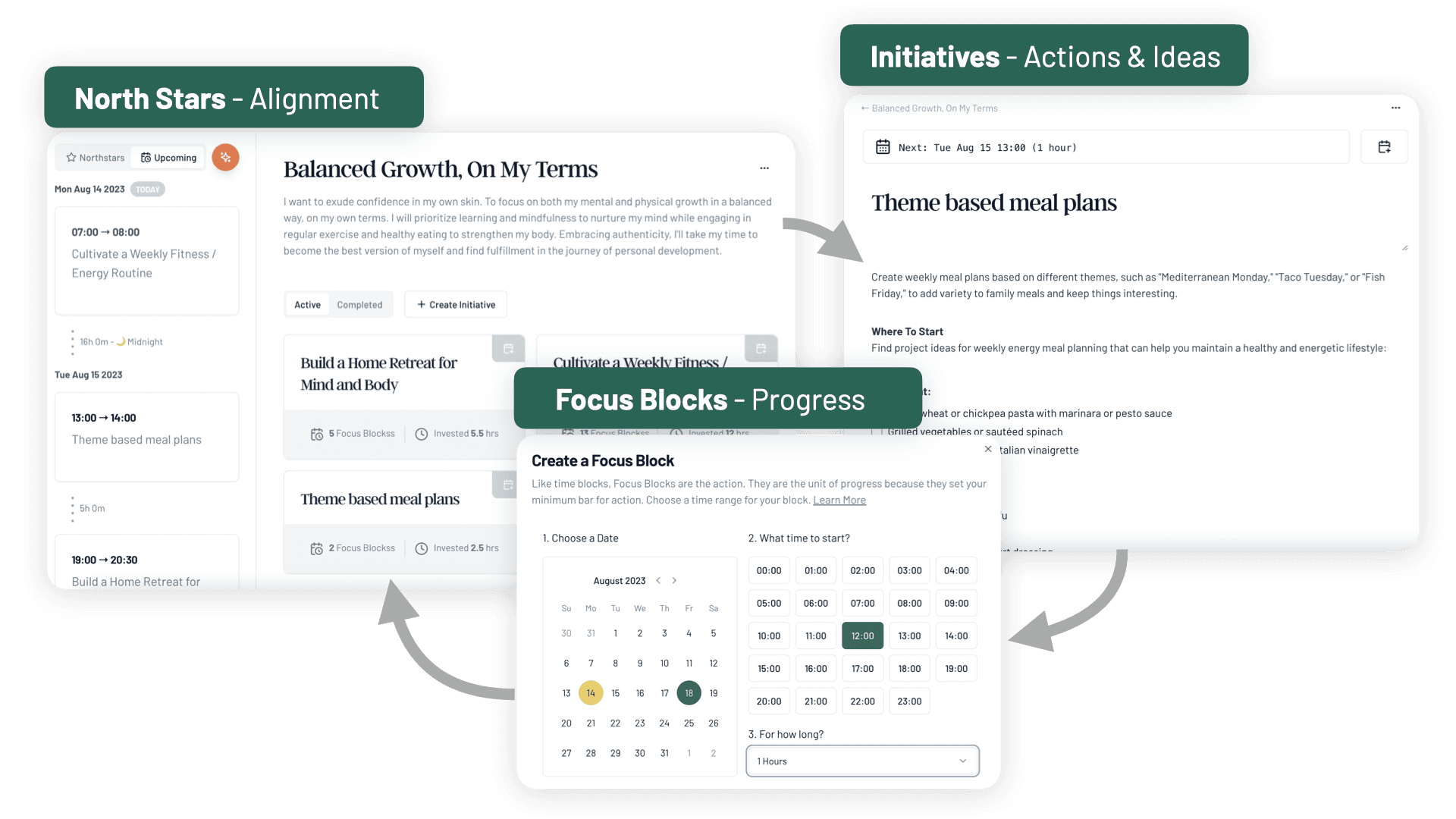Start Here
II. The Time Flow System: Take Control of Your Time and Goals
Life can often feel like a whirlwind of chaos, where our carefully planned schedules and goals frequently get derailed. Conflicting priorities, urgent tasks, and unforeseen challenges can easily push the important things to the wayside. It's a common struggle we all face. However, there is a way to regain control of your time and make steady progress toward your life goals.
The Time Flow System is a pragmatic approach to time management that helps you stay focused on the big picture while providing the flexibility to adapt to shifting schedules.
This post will show you the ropes to show you how it works.
Read time: ~5 mins
A Brief Overview of the Time Flow System
At its core, the Time Flow System revolves around three key elements:
North Stars: These are your guiding life aspirations, similar to milestones on a map.
Initiatives / Action Recipes: Initiatives are collections of action blueprints designed to drive progress toward your North Stars.
Focus Blocks: These are dedicated time blocks for focused execution.
They seem simple enough, but it's how they are used and the philosophy behind them that sets the Time Flow System apart.
Let's delve deeper into how the Time Flow System addresses the toughest time management challenges.

Problem 1
Lack of Clarity and Focus
Many of us are familiar with the daily grind of tackling an endless to-do list. It's a list filled with tasks that seem never-ending, and the typical approach is to dive in and work through it as best as we can. However, when you're stuck in this pattern, it becomes challenging to prioritize and comprehend what truly matters. This lack of clarity leads to stress, inefficiency and getting overwhelmed.
Schedule by Goals, Not by Tasks.
In the Time Flow System, we schedule entire Initiatives (which are like projects) as a whole, instead of individual actions or tasks.
For instance, instead of scheduling 30 minutes each day to "check emails," you'd schedule a daily "Streamline Communications" initiative. This initiative would have a set of email-related actions to not only process emails, but to systematically adapt better communications tactics that are all aligned towards spending less time and effort
So you may be spending the same amount of time, but instead of just treading water, you are making meaningful progress to help you save time.
The beauty of this approach is that nothing is ad-hoc. You've already vetted the actions and know what output you're aiming for. There are no scattered or generic tasks; everything is connected and aligned to a common goal, giving your to-do list a clear and purposeful intention.

Problem 2
Rigid Plans and Schedules
Our carefully planned calendars can look very productive... on paper. They're jam-packed with back-to-back meetings, projects, and tasks, making use of every single hour of your time. But this approach assumes that everything goes according to plan, with no room for flexibility when unexpected tasks or priorities arise. The result is a constant feeling of being rushed, distracted, and finding it hard to focus when time is so tight.
Reclaim Your Time Gaps.
The truth is that we never have the time we expect or plan to have. Time Gaps are the chunks of time lost between the cracks, and can consume 20% to 50% of your day. They happen because things never go 100% according to plan.
So instead of setting up schedules or projects with rigid objectives, tasks and deadlines, the Time Flow System takes a different approach.
In the Time Flow System, you are constantly collecting a flexible list of ready-to-go actions that can adapt to different scenarios and time constraints. If you have an hour, you'll have an action for that. If you suddenly have 20 minutes, you'll have an action for that situation too.
The focus is on making progress, covering small but concrete wins first, rather than attempting to do everything in one shot.
The philosophy of "Plan Weekly, Do Daily" underpins this approach. You set weekly progress goals and have the flexibility to choose daily actions based on your circumstances. With ready-to-go Action Recipes, you can easily select the best action for each situation. Your Initiatives evolve and grow organically, rather than remaining rigid structures.
Ready to Reclaim Your Time?
You can get started today with the right combinations of tools, ready-to-go resources, and expert guidance. See all the solutions you can get at your fingertips.

Problem 3
Decision & Priority Paralysis
Priority Paralysis is when your routines and schedule gets to a point where everything seems equally important or urgent, a hundred things are pulling you at the same time, and everything you do just feels like treading water. Your time is being funnelled away, but you're not really going anywhere.
Priority Paralysis happens when your actions become... just actions. Yes, you might be a busy blur of activity. But your actions are just going through the motions and are no longer aligned with any concrete goal or direction. Because they aren't in alignment with your life, all they do is maintain the status quo.
It's very easy to lose sight of the big picture when reality smashes against our original goals and intentions. Without a flexible system, you lose track of where you're at, and what type of progress you should be aiming for. Like when an endless string of "urgent things" shifts all your attention away from things that really matter. Eventually, you just forget what they are and it all just becomes a blur.
When this happens, priorities become ad-hoc "in-the-moment" decisions. And that almost always leads to poor results and regret.
Align Your Life & Choose Your Battles.
Inthe Time Flow System, alignment is the guiding principle. Everything needs to be aligned to something bigger. And it happens at every single step.
Actions are aligned to Initiatives which have specific milestones.
Initiatives are aligned to bigger North Star goals that anchor them to a direction.
Because the only way to have clarity on you priorities is to know what they are aligned to.
That also means not trying to achieve everything at once. Our time, energy and focus is limited. You have to choose your battles. Sometimes that means letting go of certain goals for the time being. But the Time Flow System always keeps you in touch with the big picture, so that you can have confidence that the things you *do* decide to focus on will deliver concrete progress and results.

Problem 4
Stuck in the Daily Grind
Our daily routines can become a prison that traps us in the same grinding routines. A breakthrough seems hard when your daily patterns are so entrenched that it seems like you can't add or take anything away without destabilizing your demands and responsibilities.
The hardest part of any breakthrough is being stuck at two important steps:
Starting something new: Getting it off the ground and gaining momentum
Doing something different: Breaking out of the entrenched routine that's holding you back
We may have a list of great ideas and projects we want to pursue but find ourselves stuck planning and re-planning. Or obsessing over every detail trying to determine the "ideal goal" or outcome. Or simply not having enough time (or confidence) to even fit something different into our routine, only to fall back into your comfort zone.
Everything Starts with Small Wins.
The Time Flow System takes a pragmatic approach to injecting change into your life. You don't need to have a crystal-clear plan from the outset. You don't need to have every detail designed and thought out to even get started.
We embrace being quick, rough and messy. That's how most great things start anyways.
North Stars and Initiatives aren't set in stone and placed on a pedestal. They evolve and change. They start as a blank canvas, and the first action you take is simply collecting ideas and actions like pieces of a puzzle.
In the Time Flow System, you start by targeting small wins. When you schedule a block of time, it's never just to tick off a to-do checkbox. You always have some sort of small win in mind. Every Action Recipe is aligned to some sort of progress, even if it's just tiny progress. So whether you invest an hour of time, or can only afford 15 minutes... you'll have the same confidence that it's worth it.
This is the only way to make realistic changes in your daily routine. You need to start small. The good thing about small is that it's a lot easier to control the results.
But small wins accumulate and grow into big wins. Because as you make progress, the Time Flow System is about constantly refining and clarifying your goals and direction. It's about embracing fluid and flexible progress.
The Time Flow System In Practice
So how does all this come together and work in practice? In the next section, we'll go through a common day-in-the-life scenario to show you.





